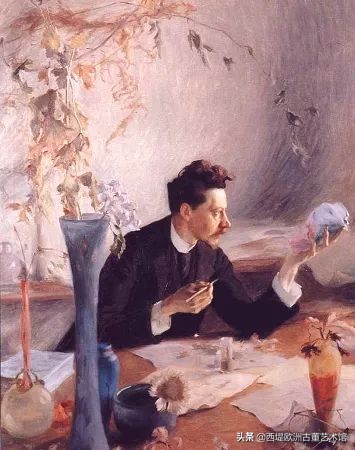Some say that the end of the 19th century and the beginning of the 20th century belonged to the natural age of Art Nouveau, where flowers, birds, fish, insects, and natural curves were used everywhere. Émile Gallé (1846-1904), a leading figure in the French Art Nouveau movement, incorporated elements of nature into a glass vase, and was hailed as a poet of art glass along with Rene Lalique.

Calais was born in 1846 in Nancy, France, to a family of craftsmen, the son of a potter and glassmaker. Calais, who has been close to flowers, birds and insects since childhood, loves nature. As a young man, he learned the skills of the glass-making process by traveling. At the same time, he also showed great interest and enthusiasm for literature, horticulture and oriental exoticism, which also revealed his artistic talent and unique artistic pursuits.
Flying Worm Manuscript, circa 1880-1890
Calais is good at using flowers and insects in nature as symbols: the bat represents a soul who can still find direction in an environment where everyone is blind; the dragonfly, knowing and explaining his short and beautiful experience of life; the honey-picking bee in the flowers presents a natural cycle; the black butterfly is a hint of death and symbolizes the birth of a new life.
Iris vase, 1900
Olive leaves are peace; wheat branches are goodness; grapes are holy; figs are generous; mother-in-law flowers are faithful; peach wood is joy; daffodils are spring, and so on.
Paintings of Calais vases in the collection of the Musée d'Orsay
After the Franco-Prussian War, his father was forced to move the factory from Alsace back to Nancy. Soon after, Calais joined the family workshop after inheriting his father's business. In 1872, he established his own independent studio and began to design and create art glass.
At the 1878 Paris World's Fair, Calais exhibited his nature-inspired glass works for the first time. At the World Expo he became famous overnight, sensationalizing all of Europe, becoming the pride of French art, and also marking the imminent birth of a new school of art.
Carp vase, circa 1875-1885
In the later period, his works also revealed a love of Japanese culture, and many of his works used decorative techniques such as gold depiction and etching, with a strong oriental style.
At the 1889 Universal Exposition in Paris, Calais exhibited three hundred pieces of glass art, innovatively blending oriental art. This time, the exhibition once again broke people's cognition and became the most eye-catching focus of the venue.
The published art vase is the work of Nancy artists such as Calais
Calais believed that color was the most important sensory stimulus, so he layered the glass of various colors, and finally acid-eroded the glass surface, so that the underlying glass color was revealed. Metal oxides are even sometimes added to the middle layers to add a vivid color.
Catalpa vase, circa 1925-1930
In the process of continuous exploration, Calais used the traditional French enamel process to decorate the glassware, but he soon turned to a more personal technique - using the process of engraving or etching, using glass of different colors and textures as materials, decorating various glassware with the theme of plants and flowers.
Column vase, circa 1920
Apple Vase, 1925
Our art smells of grass, and beauty and selflessness perfume our lives.
—Emile Calais
In addition to designing glassware, Calais also produces many pieces of fine wood furniture full of natural style.
Dragonfly Display Case, circa 1904-1905
Case of drawers in a fine wood inlay, 1900
Calais's furniture, like his glass designs, pursues a series of fluid and asymmetrical shapes; its decorative themes are dominated by exotic plants and insect shapes, and flowers blooming and flower-leaf entanglements make up the unique surface decorative effects of these works.
Calais often uses the fine wood inlay process to decorate it, making the furniture it designs exquisite and elegant. His most famous design in furniture is the Sleeping Butterfly Bed in 1904 – Dawn and Dusk , where glass and mother-of-pearl used in the butterfly's body and wings convey thin skin , and alternating black and white patterns on wood reproduce the markings of the wings.
In 1901, Calais founded the L'Ecole de Nancy (1860-1945), the brothers of Auguste Daum (1853-1909) and Antonin Daum (1864-1930), René Lalique (1860-1945), who inaugurated his first president, the most important faction of the French Art Nouveau movement.
Exhibition of the Musée décor de Paris, Académie de Nancy
In the final artistic time, Calais's work presents a peculiar shape and bright colors. A closer look at Calais's works reveals countless exquisite details, full of poetry and literature.